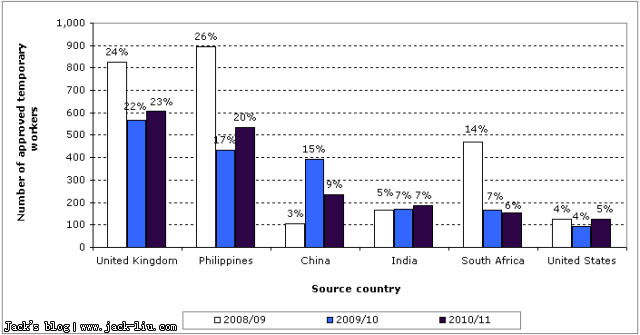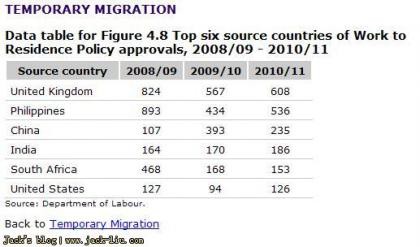现在我要引入一个关键数据WTR,结合WTR数据,我们将可以准确的得到大家最关心的一个数据——无工作担保申请新西兰技术移民的成功率。
根据新西兰劳工部提供的数据,在2010~2011年度,一共有2666人被批予Work to Residence Visa,而年度获批的主申请人总人数8931人,这说明总共有11597人是获得了PR或WTR。在PR获批的8931人中,有90%是持有工作担保的,最终可以确定3559人无工作担保提交了技术移民申请,拿到PR的则是893人,经过计算,在不考虑拒签人数的情况下(劳工部未提供拒签人数),在所有无工作担保申请人里面,只有25%的人可以获得PR;而总申请人(持有或未持有job offer)当中,其成功率为7%。
下面再来看中国的数据,在2010~2011年度,一共有1075名中国籍主申请人获得新西兰的PR,而这里面有86人是无工作担保获得PR,通过上表可以得知,一共有235名中国籍主申请人在申请SMC时被给予WTR,由于在持有工作担保的情况下提交SMC申请,是不会给WTR的,要么下签,要么拒签,所以这意味着一共有321名中国籍主申请人在无工作担保的情况下,向新西兰移民局提交了SMC申请,获得PR的人数是86人。亲爱的朋友们,答案出来了,无工作担保向移民局提交移民申请,其中有26%的人可以获得PR,这同时也意味着74%的人会被给予WTR;而最终无工作担保提交移民申请,在总申请1075人当中,成功率为8%。
中国籍申请人无工作担保申请的获批率其实已经达到移民局的平均水平,属于中段位置,仅低于欧美国家(如英国),略高于印度与菲律宾。
PS: 以上Work to Residence Visa数据可能还包括在艺术,文化,体育领域的特殊人才申请到的此签证,但多数均为申请SMC而被给予此签证。
总结:
申请新西兰技术移民,在新西兰境内申请成功率远远高于在海外申请;持有job offer申请成功率远远高于无job offer申请,但无job offer在中国境内向移民局提交申请,也并非传言中的一定就会失败,只是有高达74%的机率会被给予WTR,仍然有26%的机会获得PR。以上的分析与数据说明,在海外直接申请绿卡,新西兰完全不同于澳大利亚与加拿大的技术移民申请,即使EOI顺利入选,海外申请新西兰绿卡的成功率依然整体上偏低,如果您能符合加拿大或澳大利亚的技术移民要求并且打算直接在海外申请绿卡,显然更适合申请澳加的技术移民,更具有确定性。
由于政策上的差异,导致的完全不同的局面,申请加拿大与澳大利亚的移民身份,其侧重点在于评估申请人当前的资历,决定是否给予绿卡,拿到绿卡登陆这个国家后,移民局不会再管你是否失业或就业困难(澳加两国新移民普遍出现登陆后因无法技能就业,博士开出租车的现象)。而新西兰的侧重点在于先看结果,再来决定是否给予绿卡,新西兰移民局更倾向于去确认申请人的贡献能力与安居能力,只有在申请人已经证明了这一点后,才会批予绿卡,新西兰的WTR政策正是为了起到这个验证作用(WTR也是新西兰独创的),这样大量避免了新移民拿到绿卡后,结果出现无法就业或人才浪费的情况。
如果您目前在海外直接申请移民的条件既不符合加拿大与澳大利亚,又不符合新西兰,特别是当您已经决定踏出国门,计划通过出国留学或工作的方式获取移民身份,那么新西兰应该是最佳的选择;新西兰在政策上非常照顾已经在新西兰留学或工作的人,最终只要你能在新西兰找到一份工作,并且工作担保真实、有效,申请居留权的成功率几乎高达100%。即使您在新西兰只是一位厨师,装修工,理发师,即使没有学历,英语能力也无法严格达到6.5的要求,但是只要您真的有一技之长,不投机取巧,能勤勤恳恳在新西兰努力工作几年,为这个国家做出纳税贡献,当你通过自己的能力,证明自己是一个自食其力的人,并且已经在新西兰生存了下来,新西兰一样会给予你居留权;反过来,这样的待遇在美国、加拿大、澳大利亚是不太可能发生的。
劳工部参考信息[引用来源]:
6.1 Introduction
Although New Zealand's economy has been affected by the global economic recession, skilled migrants are still an important part of New Zealand's overall development. Labour shortages remain, particularly in some skilled areas. New Zealand firms continue to report that skilled labour is becoming increasingly difficult to find and could constrain growth. New Zealand needs skilled migrants to contribute to productivity, skills acquisition, diversity, and growth in a range of industries.
In 2010/11, 23,145 people (57 percent of residence approvals through the New Zealand Residence Programme) were approved for residence through the Skilled/Business Stream. Of these people, 21,212 (92 percent) were approved through the Skilled Migrant Category (SMC), 1,432 (6 percent) through the Residence from Work Category, and 487 (2 percent) through the Business Immigration Policy.
This chapter provides a high-level analysis of residence approvals through the Skilled/Business Stream in 2010/11.
6.2.1 Source country of Skilled Migrant Category approvals
In 2010/11, 21,212 people were approved for residence through the SMC. SMC approvals accounted for 52 percent of all residence approvals in 2010/11, down from 58 percent in 2009/10.
Although people from 110 different source countries were approved in 2010/11, 71 percent were from just six countries. Figure 6.2 shows that the United Kingdom remains the largest source country of skilled migrants (17 percent) with India the second largest (13 percent). The proportion from the United Kingdom has been declining in recent years whilst India has shown consistent growth in the last 3 years.
6.2.3 Points claimed by Skilled Migrant Category principal applicants
In total, 8,931 SMC principal applicants (90 percent) were awarded points for a job or job offer in New Zealand (78 percent for their current employment and 12 percent for an offer of skilled employment). This proportion is higher than the 81 percent who were awarded points for a job or job offer in New Zealand in 2009/10.
In 2010/11, 8,372 principal applicants (85 percent) were approved onshore. Of the onshore applicants, 97 percent had a job offer or current skilled employment in New Zealand. The remaining 1,531 principal applicants were approved offshore (15 percent), and 52 percent had a job offer or current skilled employment in New Zealand.
Most principal applicants (70 percent) gained points in 2010/11 for relevant work experience. Almost half (47 percent) gained bonus points for New Zealand work experience in 2010/11. Sixteen percent gained additional bonus points for work experience in an identified growth area or an area of absolute skills shortage.
Of the top six source countries of principal skilled migrants, Fiji had the highest proportion of principal applicants with a job or job offer (98 percent) and the United Kingdom had the lowest (85 percent). South Africa had the highest proportion of principal applicants with relevant work experience (94 percent) and China had the lowest (31 percent) (see Figure 6.5). Migrants from China and India are less likely to have work experience because they tend to be younger (on average) and most transition to residence via study rather than from a work visa.
转载请注明来源于Jack Liu博客,本文地址://www.jack-liu.com/post-148.html



 New Zealand
New Zealand China
China Australia
Australia Thailand
Thailand United States
United States